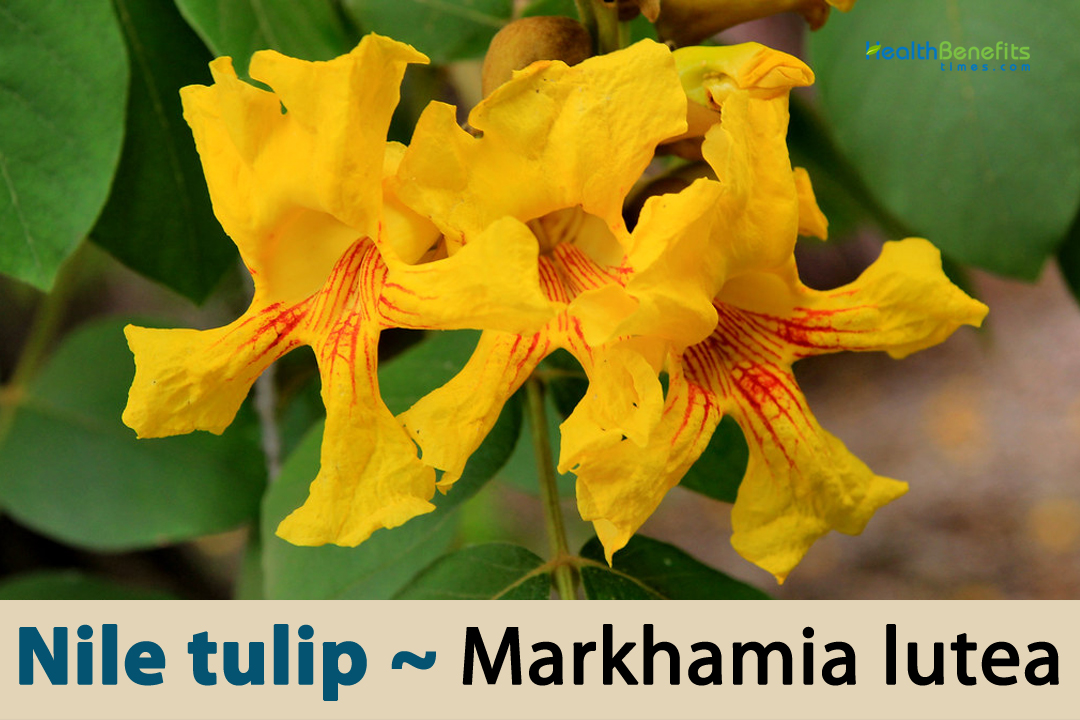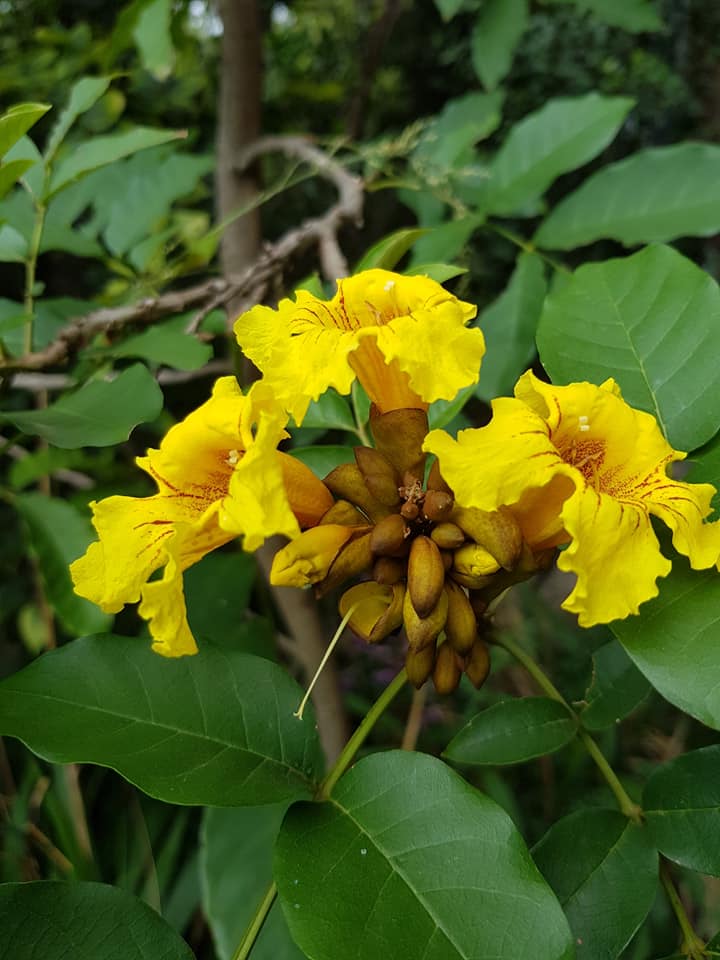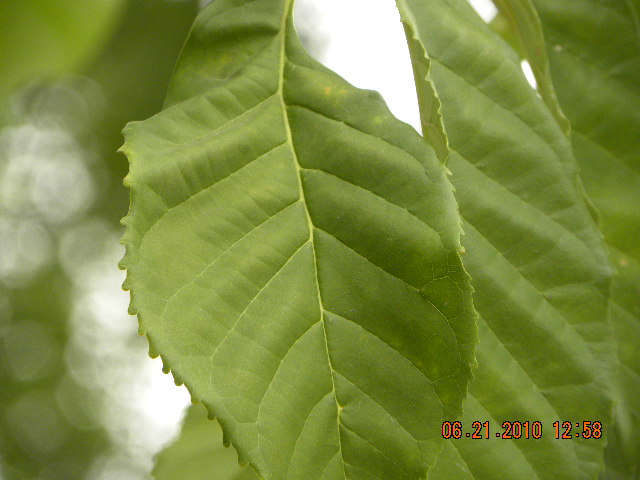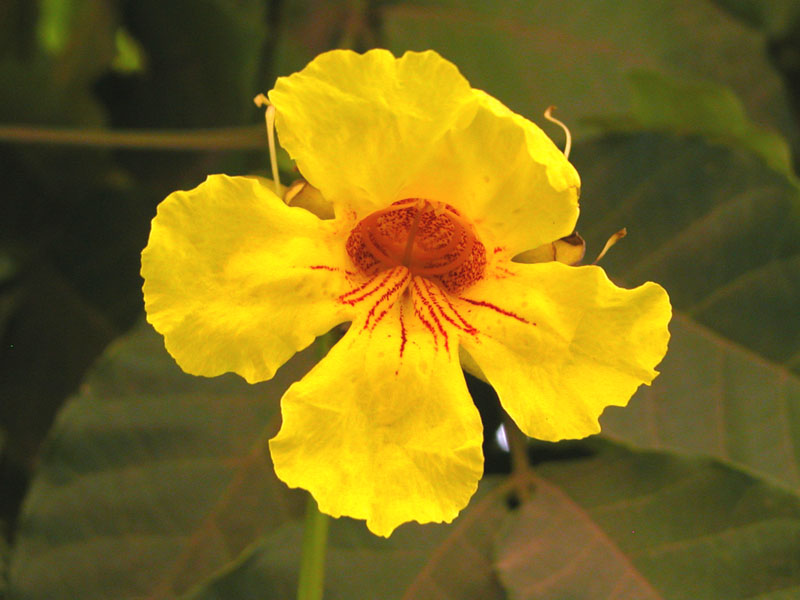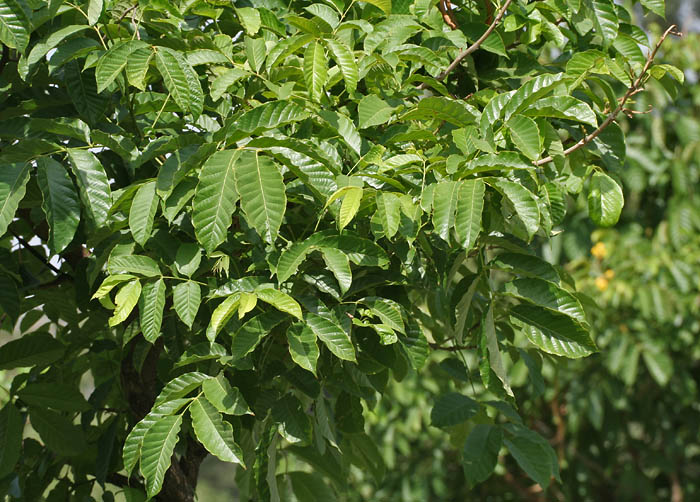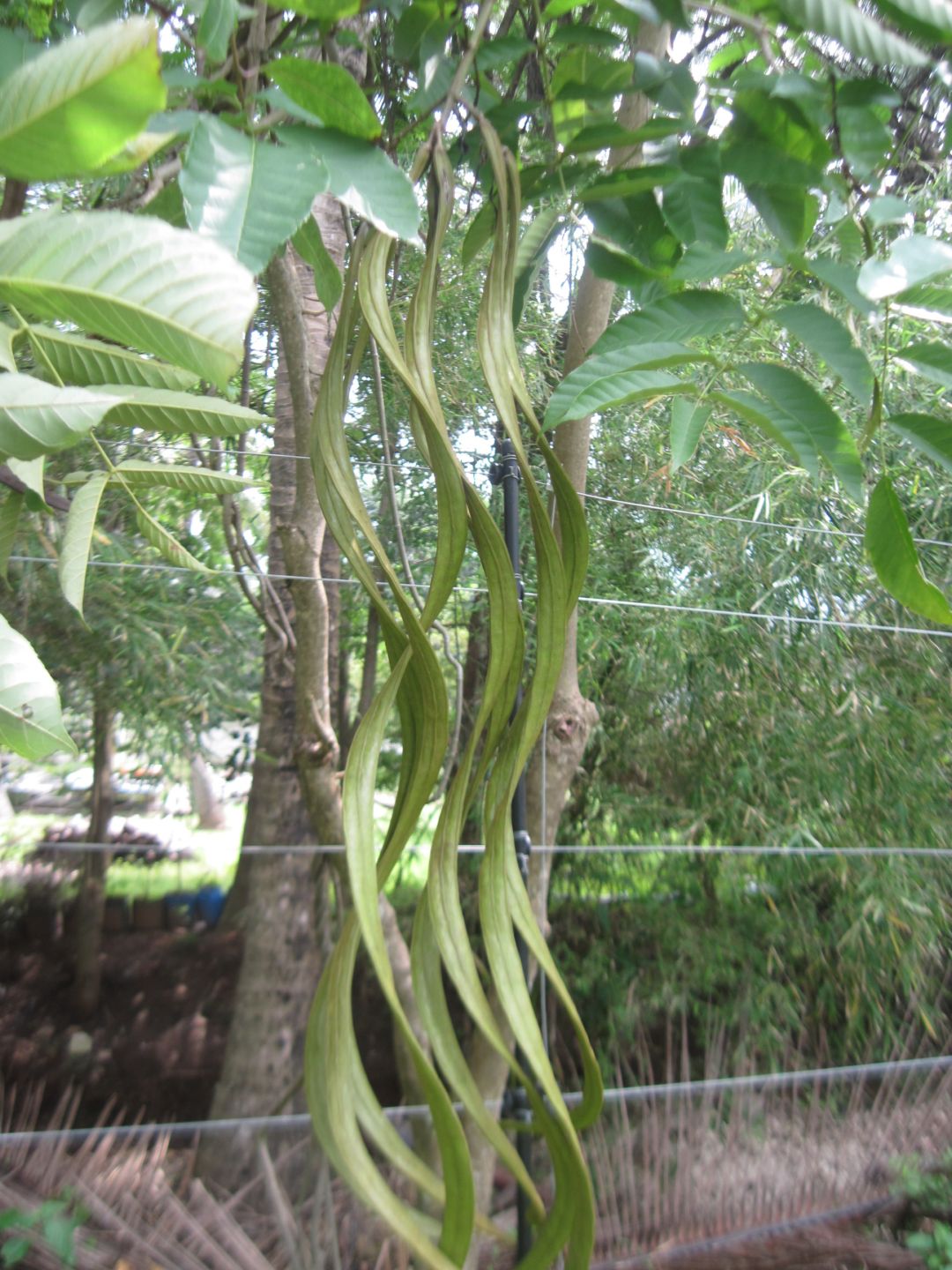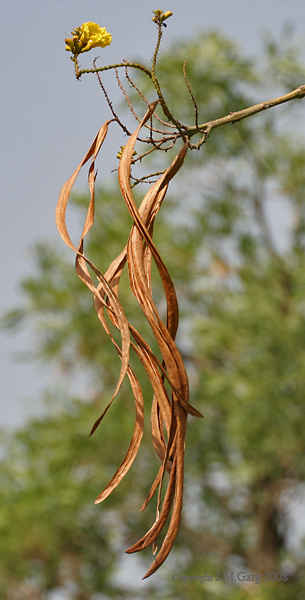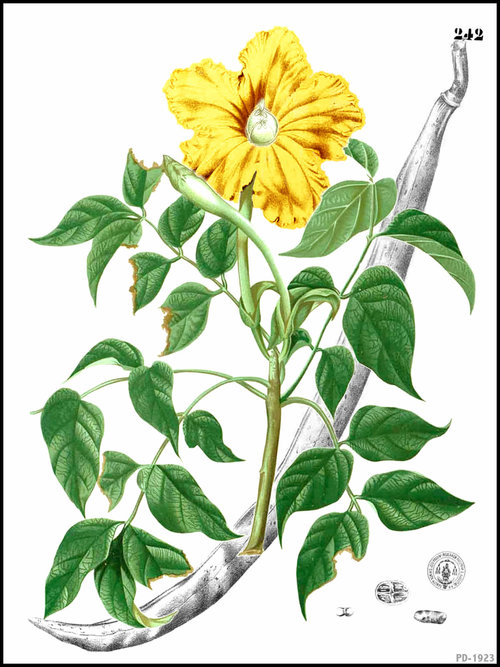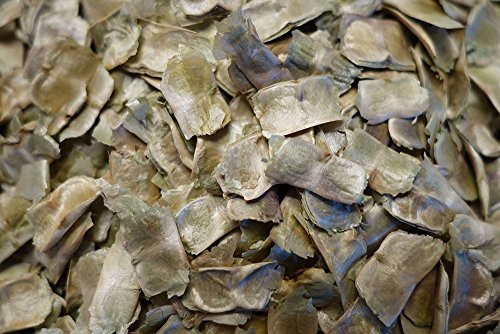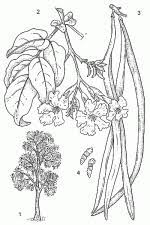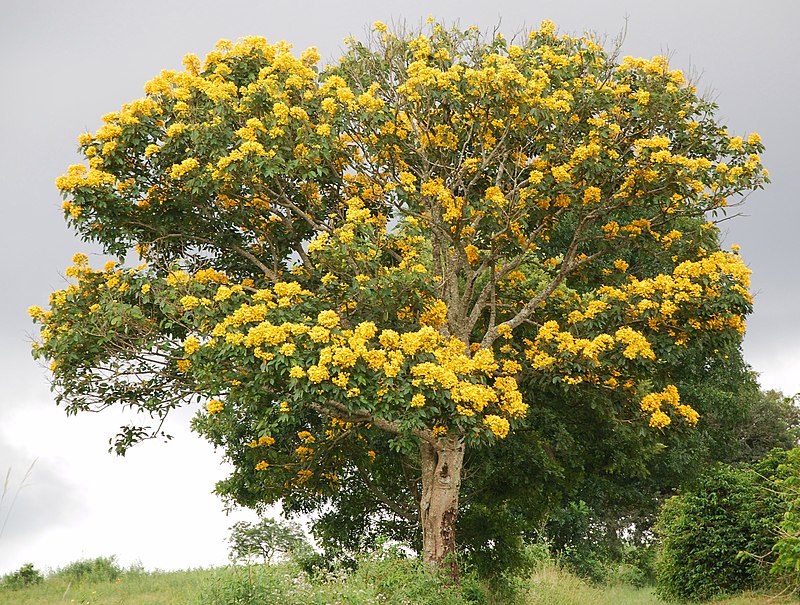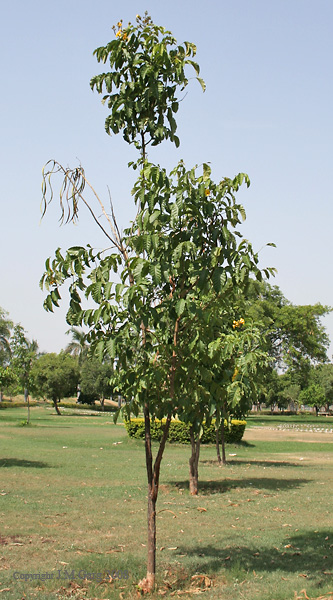The genus name “Markhamia” was given to this plant to honor the British traveler, geographer, and botanist Clements Robert Markham. Clements Robert Markham (1830–1916) was an important figure in geography and travel, and he was also very interested in the natural sciences, especially botany. “Lutea” comes from the Latin word “luteus,” which means “yellow.” The name likely comes from the bright yellow color of Markhamia lutea’s flowers, which is one of the plant’s most noticeable traits. It can be grown as a decorative plant or to filter out other plants. The Nile tulip is an important tree in many places because of its beautiful flowers and cultural importance. It’s sometimes linked to celebrations, traditions, and old ways of doing things. In places with the right temperature, it is often grown as an ornamental plant in gardens, parks, and urban areas.
Nile Tulip Facts
| Nile tulip Quick Facts | |
|---|---|
| Name: | Nile tulip |
| Scientific Name: | Markhamia lutea |
| Origin | Countries in East Africa such as Kenya, Tanzania, Uganda, Rwanda, Burundi, and parts of Sudan and Ethiopia |
| Colors | Initially green turning to brown or brownish-gray as they mature |
| Shapes | Long, thin, brown capsule is elongated and typically cylindrical or slightly curved |
| Taste | Slightly bitter or astringent taste |
| Health benefits | Anti-Inflammatory Potential, Antimicrobial Activity, Analgesic Properties, Digestive Health, Wound Healing, Skin Conditions, Fever Reduction |
| Name | Nile tulip |
|---|---|
| Scientific Name | Markhamia lutea |
| Native | Countries in East Africa such as Kenya, Tanzania, Uganda, Rwanda, Burundi, and parts of Sudan and Ethiopia |
| Common Names | Nile Lily, Nile Trumpet Flower, Golden Trumpet Tree, Nile Orchid Tree, Yellow Bell Tree, Yellow African Tulip Tree, Nile Redwood, Yellow Jacaranda Tree, Yellow African Pear, Yellow Bells |
| Name in Other Languages | Afrikaans: Nyltulpeboom Arabic: Tulib al-Nil (توليب النيل) Armenian: Nila’i tulip (Նիլայի տուլիպ) Assamese: Neel Tulip (নীল টিউলিপ) Bengali: Neel Tulip (নীল টিউলিপ), Neelkanth (নীলকন্ঠ) Bulgarian: Nilski tyulpan (Нилски тюлпан) Chichewa: Mkufi Chinese: Níluò Yùjīnxiāng (尼罗郁金香) Croatian: Nilski tulipan Czech: Nilský tulipán, Nilská tulipán Danish: Nil-tulipan Dutch: Nijltulp English: Nile trumpet, Siala, Nile tulip, Nile trumpet tree, Siala tree, yellow trumpet tree East Africa: Mgambo Estonian: Niiluse tulikas Filipino: Nile Tulipang-kahoy Finnish: Niilin tulppaani, Kameruninputkitrumpetti, Putkitrumpetti French: Tulipe du Nil, markhamia Georgian: Nilis tulipani (ნილის ტულიპანი) German: Nil-Tulpe, gelber Trompetenbaum Greek: Aigyptiakós toulípan (Αιγυπτιακός τουλίπαν) Gujarati: Neel Tulip (નીલ ટ્યુલિપ) Hausa: Yar Kifi Hebrew: Tulip Nil (טוליפ ניל) Hindi: Neel Tulip (नील ट्यूलिप) Hungarian: Níluszi tulipán Icelandic: Nil-tylpan Italian: Tulipano del Nilo Japanese: Nairu Chūrippu (ナイルチューリップ), Mākamia rutea (マーカミア・ルテア) Kannada: Nail Tulip (ನೈಲ್ ಟ್ಯೂಲಿಪ್), Nailee Bandya (ನೈಲೀ ಬಂದ್ಯ) Kazakh: Nil lalek (Нил лалек) Kenya: Ekokwait, kumusiola, kyoo, lusiola, mobet, muu, sogdu Korean: Nail Tyullip (나일튤립) Kyrgyz: Nil tyul’pan (Нил тюльпан) Latvian: Nīlas tulpe Lithuanian: Nilinis tulpė Malayalam: Nail Tulip (നൈല് ട്യൂലിപ്പ്), Neela Parijatham (നീല പാരിജാതം) Malaysia: Bunga Terompet Marathi: Nayal Tulip (नायल ट्यूलिप), Nayal Phul (नायल फुल) Mongolian: Nil chuluu (Нил чулуу) Nepali: Nail Tulip (नाइल टुलिप), Neel Phool (नील फूल) Norwegian: Nil-tulipan Oriya: Neel Tulip (ନୀଳ ଟ୍ୟୁଲିପ) Persian: Gol-e Laleh-e Nili (گل لاله نیلی) Polish: Tulipan Nilu, Nil tulipanowiec Portuguese: Tulipa-do-Nilo, marcâmia Punjabi: Neel Tulip (ਨੀਲ ਟਿਊਲਿਪ) Romanian: Tulipanul Nilului Russian: Nilsʹkiy tyulʹpan (Нильский тюльпан), zolotaya markkhamiya (золотая маркхамия), markkhamiya zholtaya (маркхамия жёлтая), tyul’pannoye derevo Nila (тюльпанное дерево Нила) Rwanda: Umusave Serbian: Nilski tulumbas (Нилски тулумбас) Shona: Mukamba Sinhala: Nawana (නවන්) Slovak: Nilský tulipán Slovenian: Nilski tulipan Somali: Laba-naab, Sogdu Spanish: Tulipán del Nilo, tulipero del Nilo Swahili: Mkalalabazo, Siala Swedish: Nil-tulpan Tajik: Tyulpani Nil (Тюльпани Нил) Tamil: Neela Tulip (நீல ட்யூலிப்) Telugu: Neel Tulip (నీల్ ట్యూలిప్), Neelakanth (నీలకంఠ) Thai: Bua Krung Surat Thani (บัวกรุงสุราษฎร์ธานี), Tiwlipnamhai (ทิวลิปน้ำไหล) Turkish: Nil Lâlesi Ukrainian: Nilʹsʹkyy tyulʹpan (Нільський тюльпан) Urdu: Neel Timur (نیل تیمور) Uzbek: Nil Tulpin Vietnamese: Hoa Chuông Trắng Yoruba: Ewe Igbo, Ewe IgboMalay Zulu: Iqadira eliluhlaza |
| Plant Growth Habit | Small to medium sized subtropical upright deciduous, evergreen shrub or small tree |
| Growing Climates | Lowland areas, lowland forests, woodlands, and disturbed areas, fringing, savannah forest, sub-montane forest |
| Soil | Grow in a variety of soils, but it likes soils that drain well |
| Plant Size | Up to 20 meters (approximately 65 feet) or more |
| Root | One large, central root that extends deep into the soil |
| Stem | Typically woody and can grow into a substantial trunk in mature trees |
| Bark | Relatively smooth, greenish-gray or brownish-gray color when young . As the tree matures, it becomes rougher and develop fissures and furrows |
| Leaf | Leaves compound, often in bunches, thin and wavy, each leaflet up to 10 cm, wider at the tip, often with round outgrowths at the base |
| Flowering season |
|
| Flower | Flower buds yellow-green and furry, splitting down 1 side as flower emerges. Flowers bright yellow, in showy terminal clusters, each trumpet shaped, to 6 cm long, with 5 frilly lobes, the throat striped with orange-red |
| Fruit Shape & Size | Long, thin, brown capsule is elongated and typically cylindrical or slightly curved, with a relatively smooth surface |
| Fruit Color | Initially green turning to brown or brownish-gray as they mature |
| Fruit Weight | Few grams to a few ounces |
| Seed | Typically small, flat, and somewhat kidney-shaped or oval about few millimeters to around a centimeter in length. They have a relatively thin and flat structure |
| Taste | Slightly bitter or astringent taste |
| Plant Parts Used | Bark, leaves, roots |
| Propagation | By seeds, stem cutting |
| Lifespan | From 50 to 100 years or more |
| Season |
|
| Available Forms |
|
| Health benefits |
|
Plant Description
You can find the Nile tulip as a small to medium-sized, upright, deciduous, evergreen bush or small tree that can grow up to 20 meters (65 feet) tall. In lowlands, fringe and grassland forests, and sub-montane forests, the plant grows. Different kinds of dirt don’t bother the plant, but it likes soils that drain well. It grows in a range of soils, such as clayey, sandy, and loamy soils. It usually grows near rivers and in places where the dirt can drain well. To treat illnesses in some African tribes, the bark and leaves of the Nile tulip tree have been used for a long time. But people who use the plant in traditional medicine should be careful, because some parts of it may contain chemicals that are harmful if not used correctly.
Pollinators like bees, butterflies, and other insects are drawn to the tree’s flowers. It also gives animals a place to live and food, which adds to the variety of the area. The wood of the Nile tulip is sometimes used for many things, like making furniture and building supplies. It is prized for how long it lasts and how well it resists termites. Even though it’s not on the list of endangered species right now, the Nile tulip is losing its habitat and trees in some places, which could become a problem for its population in the future. Conservation measures are very important to make sure that this species stays alive.
Appropriate growing environment for Nile Tulip
Nile tulip is a tropical tree species native to certain regions of Africa. Its natural habitat consists of various types of tropical and subtropical environments. Here’s a description of the typical habitat for Nile tulip:
- Geographic Range: Many countries in East Africa are home to the Nile flower. Some of the places you can find it are Kenya, Tanzania, Uganda, Rwanda, Burundi, and some parts of Sudan and Ethiopia. It may have special places to live in these countries.
- Altitude: Most of the time, the Nile tulip grows between sea level and about 1,500 meters (4,900 feet) above sea level. Its natural habitat can be both lowlands and places with moderate elevation.
- Climate: The Nile tulip does best in tropical and subtropical areas with warm temperatures and clear wet and dry seasons. It has grown in places where there is a clear wet season and a dry season.
- Rainfall: It usually grows in places that get mild to heavy rain. Its range usually goes along with places that get between 900 and 1,500 millimeters (35 to 59 inches) of rain a year.
- Soil: The Nile tulip can grow in a variety of soils, but it likes soils that drain well. In different types of soil, like clayey, sandy, and loamy soils, it can be found. It usually grows near rivers and in places where the dirt can drain well.
- Habitat Types: Most of the time, the Nile tulip lives in riparian environments, which are places near rivers and streams. It gains from the water and nutrients that these bodies of water provide. It can also be found in savannas, open woods, and forests.
- Light Requirements: This type of tree usually grows in open or mostly open places, and it does best where it gets lots of sunlight.
- Biodiversity: In its natural environment, the Nile tulip helps to keep it diverse by offering food and shelter for many animal species, such as birds, insects, and mammals.
- Human Cultivation: Nile tulips can be found in their natural habitat, but they are also often grown as ornamentals in gardens, parks, and urban areas with the right temperature.
Roots
The taproot system of the Nile tulip means that it has one big root in the middle that goes deep into the ground. The taproot is the plant’s main support structure. It helps keep the plant stable and stops it from falling over in bad weather or strong winds. Lateral roots spread out horizontally into the ground from the taproot. These side roots are very important for taking in water and nutrients. They have many tiny hairs on their roots that make the surface area bigger so that they can take in more water and minerals from the dirt. It may sometimes lead to adventitious roots. These are roots that grow from parts of the plant that aren’t roots, like stems or leaves. They can be helpful for adding support or security. Depending on what the plant needs, adventitious roots can grow above or below ground.
Some plants, like some trees, may grow special roots that can store extra water or nutrition for when the conditions are right. But storage roots aren’t often seen in this species, and it’s not something that’s commonly mentioned. In some situations, certain plants make root clusters with bacteria that fix nitrogen. These bumps can help the plant take in nitrogen from the air and change it into a form that it can use for growth. If Nile tulip has root nodules, they will only show up if the soil is right and the plant is close to microorganisms that fix nitrogen.
Stem
The main stem of the Nile tulip is usually made of wood, and in mature trees, it can grow into a big trunk. This main stem runs through the middle of the plant and holds the whole tree together. There are vascular cells in it, like xylem and phloem that move water, nutrients, and sugars around the plant. Branches grow from the main stem and go outward from the trunk. Each of these stems has leaves, flowers, and sometimes fruits on it. Different trees have different branching patterns, but most of them have a top that is spread out and not perfectly round.
You might find yearly growth rings in mature woody stems, like the trunk of the Nile tulip. These rings, one made every year, show how much the plant has grown over time. By counting these rings, you can find out how old the tree is. There are small bumps on the stem’s surface called lenticels that let gases move between the cells inside and the outside world. They help the plant breathe, and you can see them more on the younger leaves. Vascular tissues, such as xylem and phloem, carry water, minerals, and sugars throughout the plant. They are found in the stem. Xylem moves water and nutrients from the roots to the rest of the plant, and phloem moves sugars made by photosynthesis to different parts of the plant.
Bark
How rough the bark is depends on how old the tree is. Younger trees have bark that is mostly smooth and may be a greenish-gray or brownish-gray color. The bark of an old tree gets rougher over time and may get cracks and furrows in it. Bark can be any color from gray to brownish-gray, depending on things like the age of the tree, its location, and the weather. There may be times when it looks speckled, with spots of different colors.
Because trees age, their bark gets thicker over time. The bark on older trees is thicker than the bark on smaller trees. The tree’s internal parts are better protected by this thicker bark. As the tree gets older, the bark changes how it feels. Young trees may have bark that is pretty smooth, but as they get older, the bark gets rougher and more fissured, which can help them handle external stresses better. The bark’s main job is to protect the vascular tissues below, like xylem and phloem, from damage caused by animals, pathogens, and environmental stresses like high and low temperatures and changes in moisture levels.
Leaves
Nile tulip stems have leaves that are grouped in pairs. This means that at each node, a single leaf connects to the stem. As you move up the stem, the leaves switch sides. Most of the time, the leaves are oval or lance-shaped. They are long and thin, with a pointy end and a base that gets narrower toward the middle. They come in different sizes, but most of the time they are medium to big. Depending on how old the tree is and how it grows, mature leaves can be several inches long. It is easy to see that Nile tulip leaves have a network of veins going through them. These channels are very important for moving water, food, and sugars around the leaf.
The leaf border is usually entire, which means it is smooth and doesn’t have any teeth or serrations along the edge. This helps make the leaf’s general shape lance-shaped. On most Nile tulip plants, the top of the leaf is dark green and the bottom is lighter green. Leaf color can change a little based on things like the amount of light and nutrients that are available. The leaves are mostly smooth, but they might feel a little rough when you touch them.
The stem and each leaf are joined at a node, which is where the leaf stalk (petiole) meets the stem. When leaves connect to the stem, they do so one at a time, going back and forth along the stem. This is called “alternating attachment.” There is a clear network of lines on the leaves. These veins are made up of vascular cells, like xylem and phloem, which move water, nutrients, and sugars around the leaf. While the tip of the leaf is pointy, the base of the leaf, which is closest to the stalk, is tapered.
Flowers
Inflorescences are groups of flowers that grow together. Usually, the flower cluster is a terminal or axillary raceme, which is a long stem with many flowers connected to it along its length. These groups can look really nice because the flowers are such a bright yellow color. Nile tulip flowers are bilaterally symmetric, which means that they can be split in half along a single line and both halves are equal. Flowers have a lot of different kinds of symmetry like this. The calyx, which is made up of petals, is the outermost whorl of the flower. In Nile tulips, the sepals are generally green and protect the flower bud that is still to grow. The corolla, which is made up of petals, is the next whorl inside the calyx. Most Nile tulip petals are bright yellow, and they are the most noticeable part of the flower.
The flower’s male sexual parts are the stamens, which are made up of a filament and an anther. Pollen, which has the male gametes (sperm cells), is made by the anthers. The pistil is the flower’s female reproductive part. It is made up of the ovary, the style, and the stigma. Ovules, which hold the female gametes (egg cells), are found in the ovary. Nile tulip flowers are pretty big, with petals that can be several inches long. This makes them easy to see and attracts bees. Nile tulip flowers stand out because of their bright yellow color, which is very vivid and noticeable. The flowers of the Nile tulip may have a mild, pleasant scent that can vary in strength based on the tree and the weather.
Fruits
The fruit is a dry shell that opens up. “Dehiscent” means that the fruit splits open to let the seeds fall out when it’s ready. The capsule is long and usually spherical or slightly curved. The surface is mostly smooth. While they’re ripe, Nile tulip fruits can change color, most of the time going from green to brown or chocolate brown. The change in color shows that the fruit is fully grown and ready to spread its seeds. Fruits come in a range of sizes, but most are a few inches long and have a cylinder shape. How long the fruit is can depend on things like how old the tree is and the weather. The shell is broken up into sections, or compartments, and each one has many small seeds inside it. When the fruit is fully grown, these pieces split open along certain lines to let the seeds out.
Seeds
The seeds of Nile tulips are usually small, flat, and shaped like kidneys or ovals. Their structure is pretty thin and flat, which helps the wind spread them around. Some Nile tulip seeds are bigger than others, but most of them are very small. Their length is only a few millimeters to a centimeter. If the seeds are ready, they can be any color from light brown to dark brown. When seeds are fully grown, they tend to be darker. Each seed has a seed coat or seed coat layer that protects it. This layer on the outside helps keep the seed safe from damage, pathogens, and external stresses.
One thing that makes seeds unique is that one end of them has an extension that looks like wings. This part is very thin and made of membranes. It works like a parachute and helps the wind move around. When the seed comes out of the dehiscent shell (fruit), the wing lets the wind carry it to new places where it might germinate.
Health benefits of Nile tulip
Nile tulip is a beautiful flowering tree primarily grown for its ornamental value due to its striking yellow flowers, it has limited documented health benefits compared to some other plants. However, it’s important to note that traditional medicine systems in East Africa have used different parts of the Nile tulip for various purposes. Here are some potential health benefits and traditional uses of Nile tulip:
1. Traditional Medicine
The Nile tulip’s bark, leaves, and roots have been used in traditional medicine to treat a wide range of illnesses in some parts of East Africa. In the past, this plant was used to treat stomachaches, diarrhea, and fevers, among other things. People have used the bark to empty their intestines.
2. Antioxidant Properties
It may have antioxidants that help protect cells from toxic damage, like many other plants. Antioxidants are good for your health in general and may help lower your chance of getting chronic diseases.
3. Anti-Inflammatory Potential
Some plant chemicals found in Nile tulip may help reduce inflammation. In traditional medicine, it has been used to ease the pain and swelling of a number of diseases.
4. Antimicrobial Activity
Few studies have been done on Nile tulip extracts, but some of them show that they may be able to kill microbes. It has been used to treat cuts and infections for a long time.
5. Analgesic Properties
Nile tulips are used to ease pain. It has been put on the skin or eaten in different ways to ease pain and soreness.
6. Digestive Health
Nile tulips have been used to treat stomach problems like gas and diarrhea. But you should be careful when using plants to treat stomach problems because they can have bad effects if you don’t do it right.
7. Wound Healing
Nile tulip products are used to help wounds get better. People thought that the plant could clean wounds and help them heal.
8. Skin Conditions
Many people have used the Nile tulip to treat skin problems like rashes and irritations. The substance was put on the skin to ease pain.
9. Fever Reduction
Nile tulip was used by traditional doctors to ease fever symptoms. It was thought to have the ability to lower fevers.
10. Traditional Cleansing Rituals
In some countries, Nile tulips have been used in rituals to clean the body and make people feel better all around.
Different uses of Nile tulip
Nile tulip is primarily valued for its ornamental qualities, particularly its striking yellow flowers. However, it has limited documented uses beyond its aesthetic appeal. Here are the different uses of Nile tulip:
- Ornamental Plant: The main and most well-known use of the Nile tulip is as a flower. It is often used in gardening, parks, and landscaping because of its bright yellow flowers. The tree’s nice looks make outdoor areas more beautiful and interesting to look at.
- Shade Tree: The broad, spreading crown of the Nile tulip can provide shade. Because of this, it is a good tree for making shady spots in parks and gardens where people can get out of the sun.
- Timber: The Nile tulip tree’s wood can be used for many things, not just one main reason. It can be used to make small things or make furniture that looks nice. It is not usually cut down in big amounts for wood, though.
- Traditional Medicine: People in some places of East Africa have used the bark, leaves, and roots of the Nile tulip as medicine for a long time. Traditional doctors have used it to treat a wide range of problems, such as wounds, pain, and digestive problems.
- Fiber: In some countries, the Nile tulip’s inner bark fibers have been used to make cordage or twine that was used for many things, like making crafts or tying up bundles of crops.
- Religious and Cultural Significance: The Nile tulip may have religious or cultural meanings in some countries and may be used in ceremonies, rituals, or old ways of doing things.
- Honey Production: Bees are drawn to the Nile tulip’s nectar-rich flowers, and when farmers put their hives nearby, the tree can help make honey in the area.
- Traditional Crafts: The wood of the Nile tulip has been used in traditional crafts in some places. Artists can use the wood to make small decorations or carvings that show off its natural beauty.
- Shelter for Wildlife: Birds and other animals can hide and lay their eggs in the Nile tulip’s thick canopy and branching structure. It can help the area biodiversity by giving animals a place to live.
- Bee Forage: Bees are drawn to Nile tulip flowers because they make juice. Beekeepers may put their hives near Nile tulip trees so that bees can find food and make honey.
- Landscaping: Nile tulip can be used in landscaping projects to make public spaces, resorts, and business properties look better, in addition to gardens and parks.
- Aesthetic Beauty: Lily of the Nile has bright yellow flowers and lush leaves that make it a favorite among gardeners and people who like plants that look nice.
- Symbolism: Some cultures see certain trees, like the Nile tulip, as culturally or symbolically important, and they may plant them or enjoy them during certain events or festivals.
- Shade and Cooling: Because its spreading canopy provides shade and helps cool the area, the Nile tulip is a great plant to have in urban green places.
- Educational Purposes: The Nile tulip can be used in schools to teach children about plants, gardening, and the natural world. Learners can be interested in it because of its unique features and beautiful flowers.
- Conservation Efforts: In some places, environmental groups and conservationists may push for planting native trees like the Nile tulip to help protect and repair natural habitats.
Side effects of Nile tulip
Nile tulip is primarily known for its ornamental value, and there is limited information available regarding its potential side effects. However, it’s important to exercise caution when handling or using any part of the Nile tulip tree, as it may contain toxic compounds, particularly in its bark and seeds. Potential side effects or considerations related to Nile tulip may include:
- Toxicity: There may be poisonous chemicals in some parts of the Nile tulip, especially the leaves and seeds. Eating these parts can cause a lot of bad things to happen, like stomach problems, nausea, vomiting, and in the worst cases, more major health problems.
- Allergic Reactions: As with many other plants, people who are allergic or sensitive to plants may get skin irritations or allergic responses when they touch Nile tulip flowers, leaves, or bark.
- Oral Toxicity: Any part of the Nile tulip, especially the seeds, should not be eaten because it can be poisonous. Any part of the tree should not be eaten by anyone, especially children and pets.
- Pregnancy and Lactation: Pregnant and nursing women should not use Nile tulip for any medical reason because it has not been proven safe for these conditions.
- Consultation with Healthcare Professionals: If you want to use Nile tulip for medical or therapeutic reasons, you should talk to a trained medical professional first. They can tell you if it’s safe and how to use it correctly.
- Environmental Impact: In some places, the Nile tulip is an alien plant that could spread and take over other plants’ space. When planting it in places where it isn’t natural, you should think about how it will affect the environment.
References:
https://www.itis.gov/servlet/SingleRpt/SingleRpt?search_topic=TSN&search_value=832827#null
https://npgsweb.ars-grin.gov/gringlobal/taxon/taxonomydetail?id=105224
https://gd.eppo.int/taxon/MKMLU
https://en.wikipedia.org/wiki/Markhamia_lutea
https://indiabiodiversity.org/species/show/230331
https://plants.usda.gov/home/plantProfile?symbol=MALU4
https://en.hortipedia.com/Markhamia_lutea
https://tropical.theferns.info/viewtropical.php?id=Markhamia+lutea
https://apps.worldagroforestry.org/treedb2/speciesprofile.php?Spid=1121
https://www.flowersofindia.net/catalog/slides/Markhamia.html


